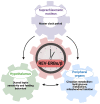The REV-ERB Nuclear Receptors: Timekeepers for the Core Clock Period and Metabolism
- PMID: 37149727
- PMCID: PMC10413432
- DOI: 10.1210/endocr/bqad069
The REV-ERB Nuclear Receptors: Timekeepers for the Core Clock Period and Metabolism
Abstract
REV-ERB nuclear receptors are potent transcriptional repressors that play an important role in the core mammalian molecular clock and metabolism. Deletion of both REV-ERBα and its largely redundant isoform REV-ERBβ in a murine tissue-specific manner have shed light on their specific functions in clock mechanisms and circadian metabolism. This review highlights recent findings that establish REV-ERBs as crucial circadian timekeepers in a variety of tissues, regulating overlapping and distinct processes that maintain normal physiology and protect from metabolic dysfunction.
Keywords: REV-ERB; circadian rhythms; desynchrony; lipids; metabolism; molecular clocks; nuclear receptors.
© The Author(s) 2023. Published by Oxford University Press on behalf of the Endocrine Society. All rights reserved. For permissions, please e-mail: journals.permissions@oup.com.
Figures



